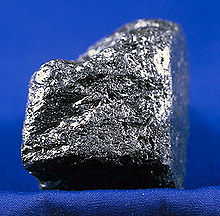Allotropy


Allotropy (or allotropism) is when a chemical element can exist in two or more different forms in the same physical state or phase. These different forms are called allotropes. Therefore, an allotrope is a different structure in which an element appears.[1] This happens when the atoms of the element are bonded together in a different way.
For example, the allotropes of carbon include:
- diamond, where the carbon atoms are bonded together in a four-cornered lattice arrangement;
- graphite, where the carbon atoms are bonded together in sheets of a six-sided lattice;
- graphene, single sheets of graphite; and
- fullerenes, where the carbon atoms are bonded together in spheres, cylinders or egg-shaped formations
Only some elements have allotropes.
The term allotropy is used for elements only, not for compounds. The more general term, used for any crystalline material, is polymorphism. Allotropy refers only to different forms of an element within the same state (i.e., different solid, liquid or gas forms); these different states are not, themselves, considered examples of allotropy.
References[change | change source]
- ↑ International Union of Pure and Applied Chemistry. "Allotrope". Compendium of Chemical Terminology Internet edition.
